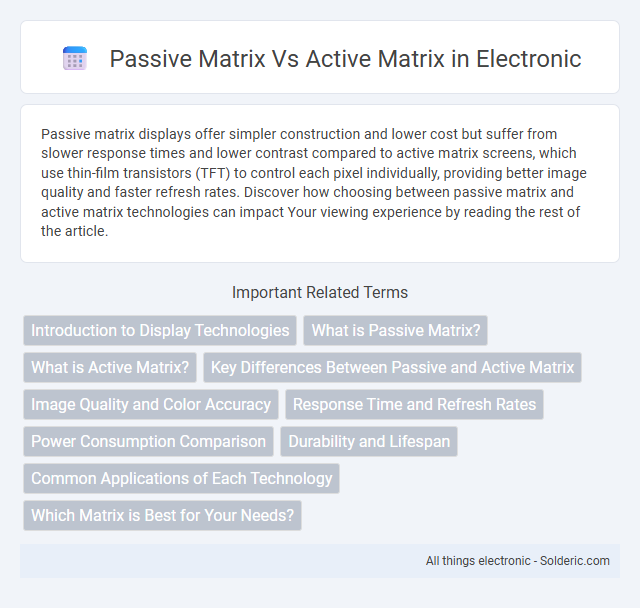Passive matrix displays offer simpler construction and lower cost but suffer from slower response times and lower contrast compared to active matrix screens, which use thin-film transistors (TFT) to control each pixel individually, providing better image quality and faster refresh rates. Discover how choosing between passive matrix and active matrix technologies can impact Your viewing experience by reading the rest of the article.
Comparison Table
| Feature | Passive Matrix | Active Matrix |
|---|---|---|
| Display Type | Simple LCD with grid-like electrode control | Thin-film transistor (TFT) LCD with individual pixel control |
| Response Time | Slower, causes motion blur | Faster, ideal for video and gaming |
| Image Quality | Lower contrast and resolution | Higher contrast, sharper images |
| Power Consumption | Lower power usage | Higher power usage due to active components |
| Cost | Generally cheaper | More expensive due to complex technology |
| Common Applications | Basic calculators, older displays | Smartphones, tablets, modern monitors |
Introduction to Display Technologies
Passive matrix displays control pixels using a simple grid of conductive lines, resulting in lower resolution and slower response times ideal for basic devices. Active matrix technology, found in most modern LCDs, uses thin-film transistors (TFTs) to actively control each pixel, providing sharper images, faster refresh rates, and better overall display quality. Understanding these differences helps you choose the appropriate display technology for your specific application or device needs.
What is Passive Matrix?
Passive Matrix technology utilizes a simple grid of horizontal and vertical conductors to control individual pixels in a display, relying on the intersection of these conductors to activate pixels without dedicated transistors. This matrix approach results in slower response times and lower resolution compared to Active Matrix displays due to the reliance on row and column scanning rather than pixel-level control. Passive Matrix displays are often found in older LCD screens and low-cost devices where high refresh rates and image quality are less critical.
What is Active Matrix?
Active Matrix is a display technology used in LCD screens where each pixel is controlled by one or more thin-film transistors (TFTs) and capacitors, allowing for faster response times and higher image quality. This technology enables precise control of individual pixels, resulting in sharper images, better color reproduction, and improved energy efficiency compared to Passive Matrix displays. Commonly used in smartphones, tablets, and high-resolution monitors, Active Matrix LCDs provide smoother video playback and enhanced visual performance.
Key Differences Between Passive and Active Matrix
Passive matrix displays use a simple grid of horizontal and vertical lines to control pixels, resulting in slower response times and lower resolution compared to active matrix technology. Active matrix displays employ thin-film transistors (TFTs) to individually control each pixel, offering higher refresh rates, better color accuracy, and improved image quality. The key differences lie in pixel control mechanisms, with passive matrix relying on multiplexing and active matrix providing direct pixel addressing for enhanced performance.
Image Quality and Color Accuracy
Active matrix displays utilize thin-film transistor (TFT) technology to deliver superior image quality and color accuracy compared to passive matrix screens, which often suffer from slower response times and lower contrast ratios. Passive matrix panels typically struggle with color bleeding and limited color depth, resulting in less vibrant and less precise color reproduction. The precise control in active matrix displays allows for sharper images with better color fidelity, making them the preferred choice for high-resolution and color-critical applications.
Response Time and Refresh Rates
Active matrix displays feature faster response times, typically in the range of 1 to 5 milliseconds, compared to passive matrix displays, which often have slower response times around 20 to 30 milliseconds. Higher refresh rates are achievable with active matrix technology, commonly supporting 60 Hz and above, enabling smoother motion and better image clarity. Passive matrix displays usually operate at lower refresh rates, resulting in slower screen updates and noticeable ghosting effects during fast-moving visuals.
Power Consumption Comparison
Active matrix displays consume more power than passive matrix displays due to the constant refreshing of individual pixels via thin-film transistors (TFTs). Passive matrix technology uses less power as it refreshes entire rows or columns at once, making it more energy-efficient but less responsive with lower image quality. You can optimize device performance by choosing passive matrix for low-power needs and active matrix for higher-quality visuals despite increased power consumption.
Durability and Lifespan
Active Matrix displays generally offer superior durability and longer lifespan compared to Passive Matrix screens due to their advanced thin-film transistor (TFT) technology, which provides better control over pixel states and reduces screen degradation. Passive Matrix displays suffer from faster wear and image retention issues because their simple grid-based control leads to higher power consumption and thermal stress on pixels. The enhanced durability of Active Matrix panels makes them more suitable for high-use applications such as smartphones and tablets, where longevity and consistent performance are critical.
Common Applications of Each Technology
Passive matrix displays are commonly used in low-cost devices such as digital watches, calculators, and simple LCD screens due to their energy efficiency and straightforward design. Active matrix technology is prevalent in smartphones, tablets, laptops, and high-resolution monitors because it offers faster response times, better image quality, and improved color reproduction. The distinction in applications arises from active matrix's ability to control individual pixels more precisely, making it suitable for devices requiring higher display performance.
Which Matrix is Best for Your Needs?
Active Matrix displays offer faster response times and higher resolution, making them ideal for gaming, video streaming, and graphic design where image quality is crucial. Passive Matrix screens tend to be more affordable and consume less power, suitable for simple devices like calculators or basic digital displays. Evaluating your usage requirements helps determine whether the superior performance of an Active Matrix or the cost-efficiency of a Passive Matrix best aligns with your needs.
Passive Matrix vs Active Matrix Infographic

 solderic.com
solderic.com